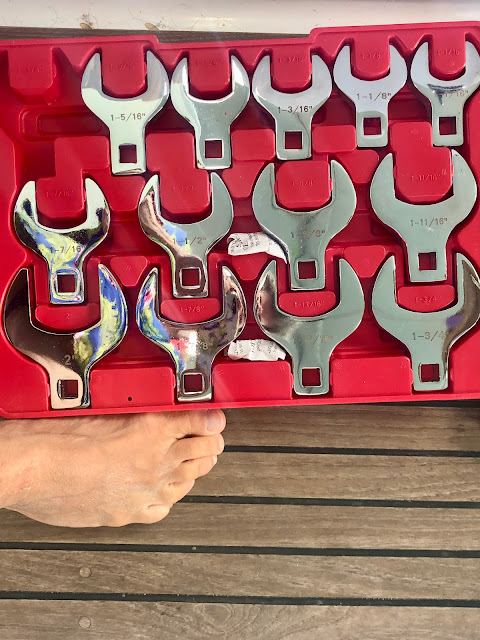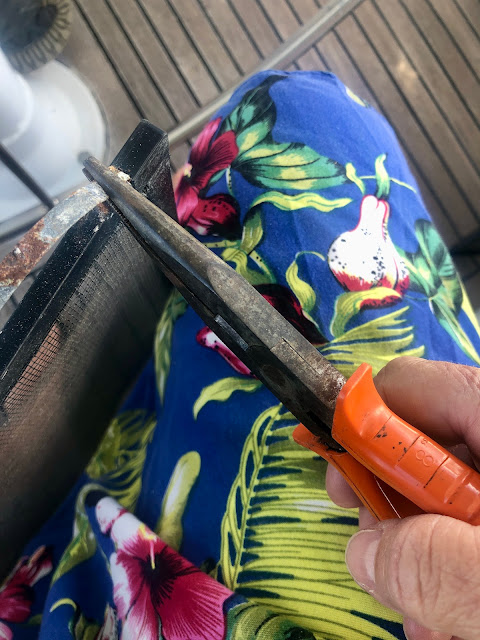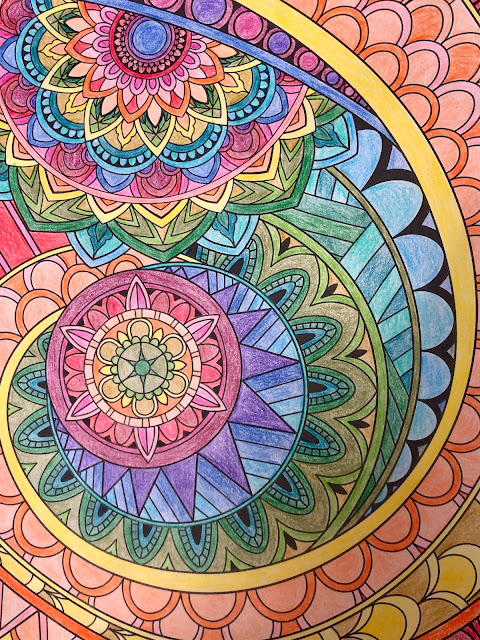The wind has continued for a few days at 15-20 knots, clocking from the north to the south over that time--with the exception of times when it has been higher. On Thursday, March 16, before nightfall, we had secured everything on deck and were prepared for another night of excitement. We were busy doing other things, and I didn't commence making dinner until about 8 p.m.; I had left it too late. The wind had been steadily rising from 15-20 from the northeast to 35. Every boat in the harbor was on channels 68 and 16 on VHF radio, and reports of boats dragging and dinghies escaping and gusts registering around 50 knots (The highest we registered over the night was 38.8.), after I had just poured some olive oil in a pan and was preparing to light a burner, made us decide to postpone dinner so that Peter could be on deck in the near gale winds to watch for other boats dragging anchor or needing assistance and I could be at the navigation table to monitor the radio and watch the electronic chart for movement of the boats having AIS (Automatic Identification System) devices. There was an hour or so of high alert, a bit of panic by other skippers, and great communication and support in the community as the weather system passed. As far as we know, no boats were grounded that night.
By 10 p.m., when the radio chatter subsided and the wind speed had lessened a bit, it was too late to make stuffed mushrooms and sautéed vegetables, so we had tortilla chips and cheese dip before going to bed. We had hoped to put some water in the tanks when the storms blew through, but there was insufficient rainfall.
After breakfast yesterday morning (Friday, March 17), I did some reading and Peter disappeared into the engine room again, continuing to work on the raw water distribution system. (He is still working on it now, as a write.)
 |
| Some of Peter's tool (my foot for size comparison) |
 |
| Peter in the engine compartment |
Later in the morning, a dinghy pulled up at the stern with one woman. Diane from S/V Tiki Tour came aboard to let us know another boat was trying to reach us on the VHF. (We had turned itd off because Peter can get distracted by it.) She also asked if I could evaluate the curricula and progress of her 11-year-old daughter Keira. They are planning to leave as soon as possible to travel to the Jumento Islands further south (The current 15-20 knot SE winds is not favorable for them.), so she asked if I could work with them that day. Of course, I am not terribly busy (unlike Peter) and welcome any opportunity to work--and I am passionate about working with students--so I invited them to come right away. She went to fetch her daughter, and I spent an hour or so with the two of them, extremely impressed with the curriculum they are using, the student accomplishments, and a pre-teen child who does not roll her eyes!
After they left, I turned my attention to manual labor. I had forgotten to clean the one potable water jerry can when I was doing the gas and diesel cans because it was not on the swim platform with me, so I retrieved it from the forepeak. I also brought to the stern the one old cowl for covering a dorade (ventilation) box on deck, which had turned yellow and sticky because of exposure to the elements (and bad materials) as well as the screens for the deck hatches. First I removed the metal springs from the frames of the screens because they were more a hindrance to placement than an advantage. I managed to remove all of them completely with pliers and vice grips without breaking them off with the exception of two; I used a rasp to file down the tiny remainders sticking up. I employed a tap and hammer to push down places where the frames had been bent a small bit by the spring removal. Then it was on to cleaning, one of may favorite things (truly!).
 |
| Sherri removing rust-encrusted springs from screens |
I cleaned the screens with soapy water. Then, I poured the soapy water in the light blue jerry can, having looked inside first and seen the microscopic life coating the bottom and sticking in small patches to the sides. Peter had to relent and let me use bleach for the project since the can is intended for drinking water storage. Even that did not work on its own, so Peter found a piece of fiberglass rod and attached a cleaning rag to it with tape for scrubbing. Even after soaking in bleach and water for over half an hour, the muck did not want to let loose easily, and I spent 15 or 20 minutes scouring the inside of the can until it was about 95% clean; there were some crannies I could not reach.
After that, I tried various anti-yellowing and cleaning products on the dorade cowl to no avail and, while Peter was not looking, resorted to bleach, which worked, although I still had to use Simple Green to remove some sticky residue. This old dorade cover does not look as good as the spotless ones that Rob and Susan brought to us from England last year, but it will be acceptable at the forepeak until we bring a better one back from England when we visit there (without the boat) this summer.
Peter found that the pricy manifold he had purchased for the engine has a 1 1/4 inch diameter hose barb to the engine, but the engine hose is 1 inch, so he needed to go to the hardware store in George Town to find an adaptor. We put away our tools, stowed the things I had been working on down below or in the pilot house, closed up the engine room and the hatches and, after Peter took a shower (because he was definitely dirty), set off in the dinghy.
Our first stop was S/V Svala from Switzerland. Their swivel hardware between their anchor and their chain had broken and they needed a replacement. We happened to have an old one, so we took it to them. Chris and Manuela are a lovely couple who have a beautiful boat, the most clean and pristine vessel I have ever seen other than superyachts which have crew for manual labor. Of course, they demurely insisted that they did not work that hard on keeping her unblemished and unsoiled.
Across the chopping harbor, we planed in the dinghy to reach George Town. I had taken books to trade at the library, but I arrived at 5 p.m., having stopped by the tourist office to drop off a thank-you note first, and the librarian was just leaving. I met Peter on the Queen's Highway running through town (and the 37-mile length of the island) and we wandered into the Bahamian Music and Heritage Festival, which was just setting up, remembering the first time we had been to this event, in 2006, when our late friend Andrew sailed with us on our first boat from Lucaya, Grand Bahama, to this harbor. He loved Bahamian music. We will attend later today and think of him.
 |
| Banner for the Music and Heritage Festival |
We picked up a few provisions and then, with jolts and bumps, rode across the waves to Chat 'n' Chill, where there was a fund-raiser for the Exuma Sailing Club. Unfortunately, the youth races had been cancelled due to the high winds and re-scheduled for today, but whether they will occur is questionable because there has been no abatement in the 15-20 knot winds, and there are still small whitecaps in the harbor. We heard that one or two of their small sailboats had sunk yesterday and they were still trying to bring them up.
 |
| The kayak and the dinghy bouncing on the water behind the stern |
 |
| Whitecaps through the galley window |
When Peter and I returned to Mantra, he went to work re-connecting things in the engine room, finding a way to jerry-rig a fix, so that the raw water system is working and things like refridgeration could function again.
I have been listening to an audio book and writing this post (while coloring) for most of the time since breakfast, while Peter has been lost in the engine room. We are just getting ready to depart for George Town for the music festival and hope to see some local races in the harbor.
 |
| Today's artwork |
No comments:
Post a Comment